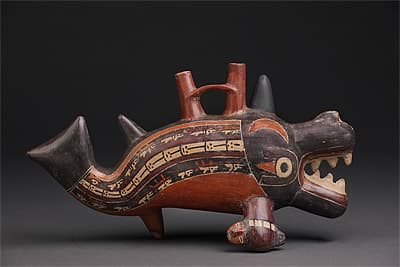
NAZCA culture South coast 100 – 700 AD
Vessel in the form of a killer whale 100-700 AD ceramic19.0 (h) x 35.2 (w) cm Ministerio de Cultura del Perú: Museo Nacional de Arqueología, Antropología e Historia del Perú, Photograph: Daniel Giannoni
The superb representation of a killer whale, or orca, goes far beyond any naturalistic rendition of the black and white animal. The artist, from the Early Nazca period,1 manages to convey the power and menace of this wolf of the sea, emphasising its open mouth, vicious teeth and the strong curve of back and tail. The bottle’s opening is made in the double-spout and bridge style.
The orca clutches a trophy head by the hair in each hand-fin, and along its body are painted offerings of fish and stylised human heads. The colour scheme of black, red and white reinforces the dramatic effect, showing the fear the cetacean inspired in the fishermen of coastal Peru.2 Orcas were ‘worshipped as one of the most important divinities’, and the motif appears on Nazca textiles and ceramics, and is engraved on the desert in the famous geoglyphs, or Nazca lines.3
Christine Dixon
1. The Early Nazca period is variously calculated, for example, as 1 to 200 AD or 100
to 300 AD.
2. Paracas: Trésors inédits du Pérou ancien, Paris: Musée du quai Branly and Flammarion 2008, p. 146.
3. Johny Isla, ‘The Nazca culture’, in Peru: Art from the Chavín to the Incas, Paris: Paris-musées, Milan: Skira 2006, fig. 67, p. 64.
The superb representation of a killer whale, or orca, goes far beyond any naturalistic rendition of the black and white animal. The artist, from the Early Nazca period,1 manages to convey the power and menace of this wolf of the sea, emphasising its open mouth, vicious teeth and the strong curve of back and tail. The bottle’s opening is made in the double-spout and bridge style.
The orca clutches a trophy head by the hair in each hand-fin, and along its body are painted offerings of fish and stylised human heads. The colour scheme of black, red and white reinforces the dramatic effect, showing the fear the cetacean inspired in the fishermen of coastal Peru.2 Orcas were ‘worshipped as one of the most important divinities’, and the motif appears on Nazca textiles and ceramics, and is engraved on the desert in the famous geoglyphs, or Nazca lines.3
Christine Dixon
1. The Early Nazca period is variously calculated, for example, as 1 to 200 AD or 100
to 300 AD.
2. Paracas: Trésors inédits du Pérou ancien, Paris: Musée du quai Branly and Flammarion 2008, p. 146.
3. Johny Isla, ‘The Nazca culture’, in Peru: Art from the Chavín to the Incas, Paris: Paris-musées, Milan: Skira 2006, fig. 67, p. 64.
The superb representation of a killer whale, or orca, goes far beyond any naturalistic rendition of the black and white animal. The artist, from the Early Nazca period,1 manages to convey the power and menace of this wolf of the sea, emphasising its open mouth, vicious teeth and the strong curve of back and tail. The bottle’s opening is made in the double-spout and bridge style.
The orca clutches a trophy head by the hair in each hand-fin, and along its body are painted offerings of fish and stylised human heads. The colour scheme of black, red and white reinforces the dramatic effect, showing the fear the cetacean inspired in the fishermen of coastal Peru.2 Orcas were ‘worshipped as one of the most important divinities’, and the motif appears on Nazca textiles and ceramics, and is engraved on the desert in the famous geoglyphs, or Nazca lines.3
Christine Dixon
1. The Early Nazca period is variously calculated, for example, as 1 to 200 AD or 100
to 300 AD.
2. Paracas: Trésors inédits du Pérou ancien, Paris: Musée du quai Branly and Flammarion 2008, p. 146.
3. Johny Isla, ‘The Nazca culture’, in Peru: Art from the Chavín to the Incas, Paris: Paris-musées, Milan: Skira 2006, fig. 67, p. 64.

